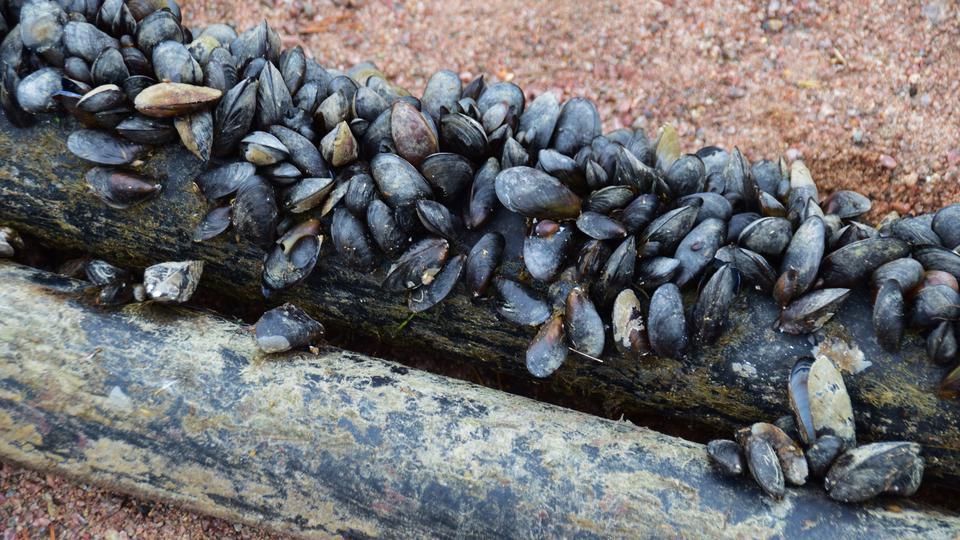
Popular science description for the project on bialves and food resources
As the need for more sustainably produced food, there is a growing realization that marine-based food production (aquaculture) must be part of the future.
Of the marine species grown it is especially beneficial to grow mussels and oysters (bivalves) because these species assimilate phytoplankton and other organic matter that is naturally present in the marine environment, and they can thus decrease the effects of eutrophication (overgrowth of algae). To calculate how much bivalves can be grown in an area, models are used which are based on food availability. These models often show that the production of bivalves can be increased, sometimes several 100 times, without running out of food for the organisms. This is because the models include the occurrence of dead organic material (detritus) in the calculations.
Although it is known that mussels and oysters can eat detritus, how important this food is for them is limited and there is a lack of information about the source of detritus (dead land-plants, dead seaweed, etc.) used by different species. In other words, today's models cannot deal with this complexity but deal with all detritus as a uniform resource, which means there is a risk that the number of bivalves predicted by the models is either overestimated or underestimated. Detritus can contribute to organisms' food in two ways. Partly, it can supplement the normal food by adding, for example micronutrients or probiotics that are normally missing in food, or detritus can replace other food.
In aquaculture, it is of particular interest to find out whether mussels and oysters use detritus as compensation when the presence of phytoplankton is low, for example in winter. There is also interest in Sweden to grow bivalves in deeper water, where there is naturally less phytoplankton, to avoid challenges associated with surface culturing. As phytoplankton availability decreases, and detritus quantity increases, with depth, there is an opportunity to study how important detritus is as a food source for mussels and oysters while also studying how depth affects the quality of mussels and oysters as food.
Species of interest to the Swedish aquaculture sector are blue mussels, the flat European oyster, and the invasive Pacific oyster. Both blue mussels and European oysters are native and currently cultivated in Sweden with an annual production of approx. 3,500 tonnes. However, it is unclear how much the species' diets overlap and whether they compete for food or not. In some areas, when different bivalves are grown together, they change their trophic niche, i.e. which food they prefer. This is an indication of competition. Understanding how food competition between different species works can provide insight into whether the species can coexist by consuming different parts of the available food and can improve the calculations of how much mussels and oysters can be grown in a specific area. This can also help us understand the risks of cultivated bivalves competing with wild stocks for food. This is especially important in view of the invasive Pacific oyster, which is currently spreading in Swedish waters.
The aim of the proposed project is therefore to investigate the role that detritus plays as food for three species of bivalves (blue mussels, European oysters and Pacific oysters) in Sweden and investigate how their food choices overlap.
The experiments will also contribute with knowledge about how depth affects the quality of the cultivated organisms and their value as food, such as protein, fat and omega-3 content. To achieve these goals we will use a combination of stable isotopes (δ13C and δ15N), fatty acid biomarkers and amino acid δ15N values to answer three ecological questions with relevance to Swedish aquaculture:
- Q1. What kinds of detritus do mussels and oysters use as food?
- Q2. How much food competition occurs between the species?
- Q3. Can mussels and oysters replace parts of their diet with detritus, and if so, with what type of detritus?
The results can contribute to better planning of the aquaculture production of mussels and oysters in Sweden and internationally, can reduce the risk of negative impacts from farmed organisms on wild stocks, and can contribute to answer questions linked to interactions between our native bivalves and the invasive Pacific oyster. In this way, an ecosystem-based management of our marine resources can be achieved.
Contact
Want to know more about IVL's services and offers? Enter your email address and choose which area you want to know more about, and we will get back to you.
